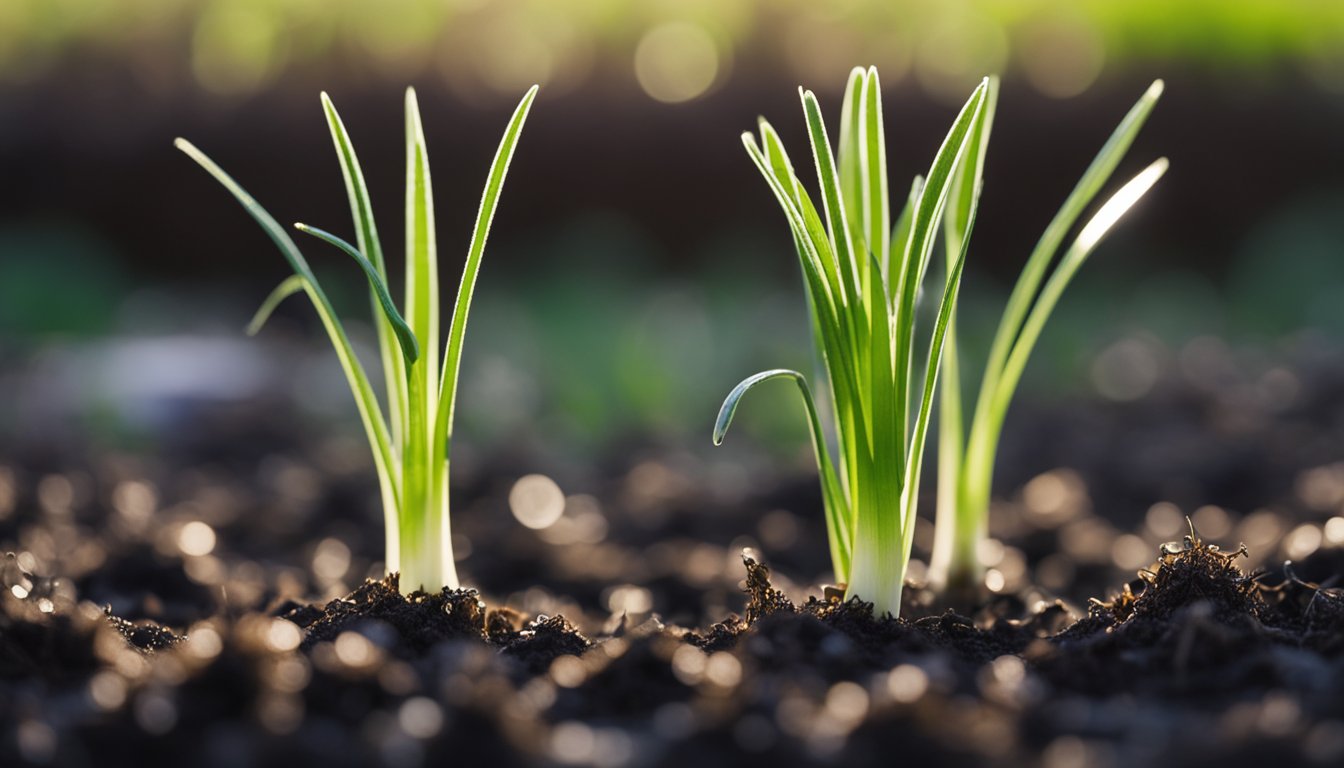If you’ve ever dreamed of growing your own fresh onions, starting from seed is one of the most rewarding ways to do it. There’s something incredibly satisfying about nurturing tiny seeds into vibrant, flavorful bulbs that can elevate your meals. Plus, planting onions from seed opens up a world of variety that you simply can’t find in store-bought bulbs.
Benefits Of Planting Onions From Seed
Planting onions from seed offers numerous advantages. First, I enjoy the broader selection of onion types. Seeds provide access to unique varieties that local stores often lack.
Growing from seed encourages a stronger and healthier plant. Seedlings adapt better to their environment, which results in robust onion bulbs. By starting from seed, I can also choose onion varieties suited to my climate.
Cost savings play a significant role, too. Seeds usually cost less, allowing me to plant multiple varieties without breaking the bank. Instead of buying sets or established plants, I invest in packets of seeds that last for several seasons.
Another benefit is the growth timeline. Seeds allow me to control when I start planting. This flexibility means I can have fresh onions ready sooner than conventional methods.
Nurturing onions from seeds gives me a sense of accomplishment. Watching tiny seeds evolve into thriving plants is rewarding. Each bulb harvested seems like a personal victory in my gardening journey.
Choosing The Right Onion Varieties

Selecting the right onion varieties is crucial for growing healthy, flavorful onions. Different types fit different growing conditions, and understanding these differences leads to a better harvest.
Short-Day vs. Long-Day Onions
Short-day onions thrive in warmer climates where daylight hours stay shorter. They form bulbs when day lengths reach around 10 to 12 hours. Varieties such as ‘Texas Super Sweet’ or ‘White Granex’ excel in these conditions. On the flip side, long-day onions require longer days, around 14 to 16 hours of sunlight. They do well in northern regions. Popular varieties include ‘Walla Walla’ and ‘Yellow Granex.’ Choosing between these types depends on your local climate and your gardening goals.
Onion Seed Sources – Planting Onions from Seed
Finding quality onion seeds is essential. Local garden centers often stock reliable varieties. I also like online stores for a broader selection. Companies like Burpee and Johnny’s Selected Seeds offer many options. Selecting seeds from reputable sources ensures strong germination rates. Community seed swaps provide unique varieties, too. You never know what gem you might discover. Always check seed packets for information on the variety and growing conditions to ensure a match for your garden.
Preparing Your Garden For Onion Seeds
Preparing my garden for planting onion seeds involves a few essential steps. Ensuring the right conditions helps boost growth and ultimately leads to a successful harvest.
Soil Requirements
Onions thrive in well-draining soil with a pH range of 6.0 to 7.5. I mix compost or aged manure into the soil to add nutrients. This not only improves fertility but also encourages healthy root development. For the best results, I aim for loose, loamy soil. Heavy clay or overly sandy soil can hinder growth, so testing the soil beforehand is critical. Using a soil test kit, I check nutrient levels and make adjustments as needed. Good soil makes happy onions!
Planting Location – Planting Onions from Seed
Choosing the right planting location also plays a crucial role. I pick an area that gets at least six hours of sunlight daily. Onions enjoy warmth and light. If it’s possible to rotate my crops, I do so, avoiding planting onions in the same spot year after year. This helps prevent soil-borne diseases.
Planting Techniques For Onions

Planting onions from seed is straightforward and rewarding. Here’s how to do it right.
Seed Sowing Methods
I typically choose two effective methods for sowing onion seeds. Direct sowing works well in prepared soil. I make small furrows, drop in seeds, and cover them lightly. Another option is starting seeds indoors. I plant them in seed trays about eight weeks before the last frost date. Indoor seedlings get a head start, ready for transplanting once the weather warms up. It’s like giving them a cozy apartment before moving to a big house!
Caring For Your Onion Plants
Caring for onion plants involves consistent attention to watering, fertilization, and pest control. I focus on these key areas to keep my onion garden thriving.
Watering And Fertilization – Planting Onions from Seed
Water onion plants deeply but infrequently. I typically water them about once a week, ensuring the soil remains moist but not soggy. If the top inch of soil feels dry, it’s time to add some water. Onions thrive with steady moisture, especially during the bulb formation stage.
I use a balanced fertilizer every four to six weeks. This helps promote healthy growth. A fertilizer with equal parts nitrogen, phosphorus, and potassium works well. I mix it into the soil, fostering strong roots and vibrant foliage. Organic options like compost or liquid seaweed also provide nutrients.
Pest Control In Onion Gardens – Planting Onions from Seed
Pest control is crucial for protecting onion plants. Regularly checking for pests makes a big difference. I often find onion maggots and thrips lurking around. To combat these, I place yellow sticky traps nearby. They attract and capture pesky insects, keeping my onions safe.
I also use companion planting to deter pests. Planting garlic or marigolds nearby works wonders. These plants can confuse pests and keep them at bay. If I spot any pests, I act quickly, utilizing insecticidal soap or neem oil for treatment. Keeping my onion plants healthy requires effort, but a bountiful harvest makes it worthwhile.
Harvesting And Storing Onions

Harvesting onions is a satisfying task. I know the excitement that comes when it’s time to pick them. Onions are ready to harvest when their green tops fall over and turn yellow. Look for signs like the tops wilting or browning, generally occurring in late summer to early fall.
I recommend gently digging them out with a fork, as this technique minimizes bruising. A simple approach involves grasping the tops and pulling slowly, allowing the bulbs to break free from the soil. Be careful not to damage the bulbs during this process; bruised onions won’t store well.
After harvesting, curing onions is crucial. This step enhances their flavor and storage life. I place my onions in a single layer in a warm, dry area with good airflow for 2 to 3 weeks. During this time, the outer skins dry out, making them more durable. I ensure they’re not in direct sunlight to prevent sunscalding.
Storing onions correctly extends their freshness. Once cured, I store them in a cool, dark location, ideally around 32°F to 40°F. A well-ventilated mesh bag or a basket works best for storage. I avoid plastic bags, as they trap moisture and lead to spoilage.
It’s crucial to check stored onions regularly. If I notice any spoilage, I remove those onions immediately to prevent spreading. Healthy onions can last several months if properly cared for. However, focusing on using them before sprouting occurs ensures the best flavor in my dishes.
Overall, harvesting and storing onions brings a sense of accomplishment. Each step, from digging them up to finding a home for them, adds joy to the gardening experience. Plus, having fresh onions ready in my kitchen feels like a win.
Before You Go – Planting Onions from Seed
Growing onions from seed has been one of the most fulfilling experiences in my gardening journey. There’s something incredibly rewarding about watching those tiny seeds transform into vibrant plants. The variety I can choose from when starting from seed opens up a world of flavors that store-bought options just can’t match.
With the right care and attention my onions thrive, adapting beautifully to my garden’s unique conditions. Harvesting them at the end of the season brings immense satisfaction. Knowing I can enjoy my homegrown onions for months adds to the joy.
If you’re considering diving into onion gardening, I encourage you to take the leap. You’ll find it’s a delightful and fruitful endeavor that enhances your culinary creations. Don’t forget to add The Herb Prof to your favorites so you don’t miss out on future articles.
References – Planting Onions from Seed
Little Herb Encyclopedia, by Jack Ritchason; N.D., Woodland Publishing Incorporated, 1995
The Ultimate Healing System, Course Manual, Copyright 1985, Don Lepore
Planetary Herbology, Michael Tierra, C.A., N.D., Lotus Press, 1988
Handbook of Medicinal Herbs, by James A. Duke, Pub. CRP Second Edition 2007
The Complete Medicinal Herbal, by Penelope Ody, Published by Dorling Kindersley
Check the Following Articles
Why the Kangaroo Fern is Perfect for Your Indoor Garden
White vs Brown Egg: Which One Should You Choose?
What Is Arrowroot? Discover Its Uses and Health Benefits
Top 3 Healthier Substitutes for Butter
Frequently Asked Questions – Planting Onions from Seed
What are the benefits of growing onions from seeds?
Growing onions from seeds offers several advantages, including access to a wider variety of onion types not typically available in stores. It also promotes the development of stronger, healthier plants that adapt better to local conditions. Additionally, planting from seeds can be more cost-effective, allowing gardeners to explore multiple varieties without spending much. Plus, onions grown from seeds can be harvested sooner than those started through conventional methods.
How do I choose the right onion variety?
Choosing the right onion variety depends on your local climate. Short-day onions, like ‘Texas Super Sweet,’ thrive in warmer regions with fewer daylight hours, while long-day onions, such as ‘Walla Walla,’ grow best in northern areas with longer days. Research your area’s daylight patterns to select the most suitable onions for optimal growth.
When is the best time to plant onion seeds?
The best time to plant onion seeds varies based on climate. Generally, seeds should be sown indoors about eight weeks before the last frost date or directly in the garden as soon as the soil is workable in early spring. This timing helps ensure that onions have enough time to grow before the warmer months.
How should I prepare my garden for planting onions?
Preparing your garden involves selecting a well-draining site that gets at least six hours of sunlight daily. Amend the soil with compost or aged manure to enhance fertility and maintain a pH of 6.0 to 7.5. It’s also essential to test your soil’s nutrient levels and practice crop rotation to reduce disease risks.
What are the care requirements for onion plants?
Onion plants require consistent care, including deep but infrequent watering once a week, especially during bulb formation. Fertilize them every four to six weeks with a balanced fertilizer or organic compost to encourage healthy growth. Additionally, monitor for pests like onion maggots and use companion planting methods or sticky traps for effective pest control.
When should I harvest my onions?
Harvest your onions when the tops start to fall over and turn yellow, typically in late summer or early fall. Gently dig them out using a fork to avoid bruising. This timing indicates that the onions are ready for curing and storage.
How do I cure and store onions properly?
To cure onions, place them in a warm, dry area for 2 to 3 weeks, allowing the outer skins to dry out. Once cured, store onions in a cool, dark place between 32°F to 40°F using mesh bags or baskets. This method helps extend freshness and flavor, enabling you to enjoy your onions for several months.
Can I grow different onion varieties together?
Yes, you can grow different onion varieties together in your garden. Just ensure each variety’s growth requirements are met, such as sunlight, watering, and soil nutrients. This approach can add diversity to your garden and provide a unique mix of flavors for your cooking needs.

